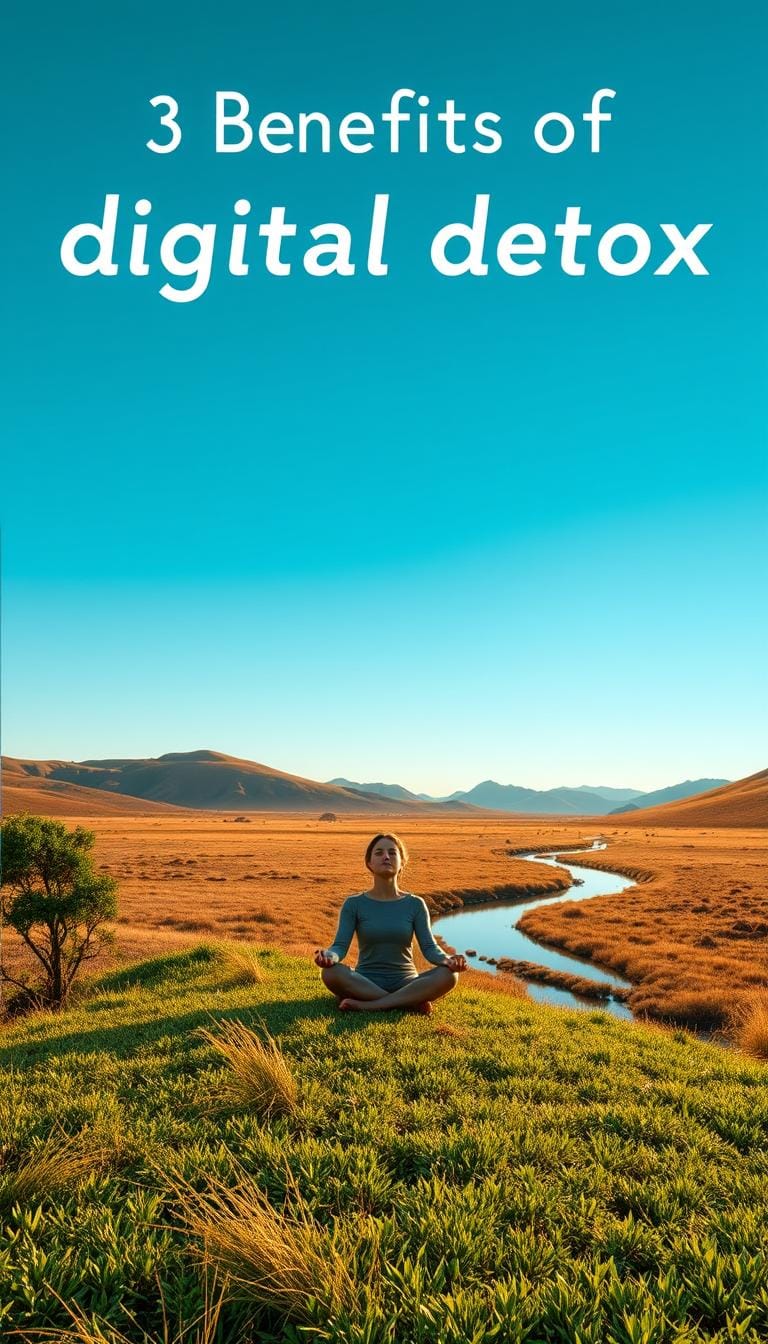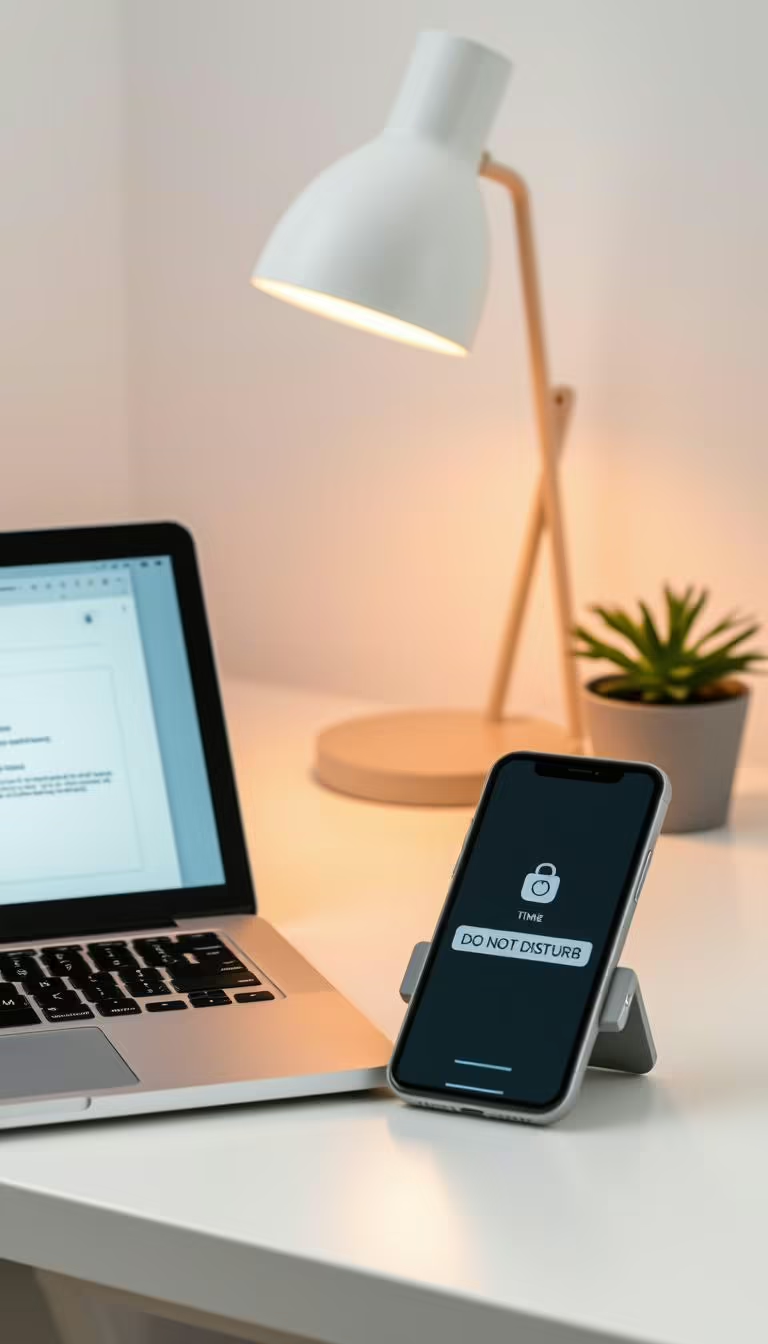Digital Detox: 5 Simple Steps to Reclaim Focus
Table of Contents
A few months ago, I felt overwhelmed by endless notifications and crowded apps. My phone had become a distraction machine. That’s when I tried a digital detox.
Cutting back on screens, even a little, changed my life. My mind felt lighter. Tasks got done faster. I rediscovered moments I’d forgotten existed.

This isn’t about quitting tech entirely. It’s about finding balance. Small changes add up. I learned to schedule social media breaks and set phone-free times.
Now, I focus on one task at a time. I want to share these steps with you. Let’s explore how a digital detox can help you gain clarity and reduce stress. The first step starts here.
Understanding the Need for a Digital Detox
Our screens buzz constantly—emails, social media, and endless notifications. This constant connection can leave us feeling drained. Let’s explore why stepping back matters.

Signs of Digital Overwhelm
Here’s what to watch for:
- Checking devices first thing in the morning
- Feeling anxious without a phone nearby
- Spending over 4 hours daily scrolling
Impact on Mental & Physical Health
Studies show chronic tech use harms well-being. Let’s compare effects:
| Category | Mental Health | Physical Health |
|---|---|---|
| Key Issues | Anxiety, burnout | Eye strain, sleep loss |
| Long-term Risks | Depression, chronic stress | Neck pain, disrupted posture |
Data from the American Psychological Association confirms 65% of adults report tech-related stress. Harvard research links blue light to sleep disruption. A digital detox helps reset this cycle.
Identifying Your Digital Overload Triggers
Unplugging begins with understanding what draws you online. Think about your habits to find patterns that lead to too much screen time. I learned that even small actions, like scrolling news on my commute, can add up. Here’s how to identify these triggers:
- Use tools like Apple Screen Time or Google Digital Wellbeing to track your daily screen time. This helps you see where hours disappear.
- Pay attention to when you mindlessly check your devices. Is it during meals, when you’re relaxing, or when you’re stressed?
- Ask yourself: “Does this app or activity really add value to my day?” Be honest about what distracts you.

Common triggers are often right in front of us. Social media, email alerts, or background TV can drain our focus. For instance, I found that work messages after hours kept me in a constant state of alertness. Recognizing these moments is essential for reducing screen time. Try turning off non-essential notifications and notice how your habits change. Swapping scroll time for walks or hobbies can help you regain hours.
Begin today by watching your daily routine. Being aware is the first step to finding balance.
Creating a Personalized Detox Plan
Starting a digital detox plan means being honest about your habits. Ask yourself: When do screens get in the way most? What small changes can you make? My journey started by finding moments where unplugging made a big difference. Here’s how to make those moments into real actions.
First, set specific goals that match your priorities. Try to be clear, like these examples:
- “No emails after 8 PM”
- “30 minutes daily device-free mornings”
- “Replace social media scrolling with journaling”
Setting Clear Goals
Goals should be clear and have a deadline. When I aimed to unplug during meals, I gave myself 2 weeks. Use a simple checklist or app to track your progress.
Customizing Your Daily Schedule
Change your routine slowly. Here’s a basic plan:
| Time | Activity |
|---|---|
| 7:00–8:00 AM | Meditation/stretching (no devices) |
| 6:00–7:00 PM | Family game night (tech-free zone) |
| 9:00 PM onward | Device charging station (bedroom off-limits for screens) |
Make these blocks fit your life. The goal is to be consistent. Small changes add up over time. Remember, it’s about making progress, not being perfect.
Implementing Screen Time Reduction Strategies
Starting tech-free living is about making small, daily choices. These choices add up over time. Consistency is key. Let’s explore how to make these changes a reality.
Practical Tips for Screen-Free Moments
- Use sunrise alarms or analog clocks instead of phone alarms to wake up without screens.
- Make certain areas in your home “device-free,” like the kitchen or bedroom, to set boundaries.
- Choose activities that don’t involve screens, like painting, cooking, or reading physical books, during your free time.
Monitoring Your Usage with Apps
Tracking your screen time helps you understand your habits. I use Apple’s Screen Time or Google’s Digital Wellbeing to set limits on apps. These tools send weekly reports that show how you’re doing, helping you make better choices.
Start small and gradually add more tech-free moments to your day. Each moment you spend without screens brings you closer to mindful living. Over time, these habits become part of your daily routine, supporting a tech-free lifestyle.
Navigating the Challenges of Unplugging
Unplugging isn’t always easy. I’ve faced moments where the buzz of notifications felt like a habit I couldn’t shake. But every hurdle has a solution. Let’s break down what to expect:
| Challenge | Solution |
|---|---|
| Fear of missing out (FOMO) | Schedule 15-minute daily check-ins with apps like Moment to track progress |
| Work demands | Set clear “no phone” hours and use Freedom app to block work emails after 8 PM |
| Physical withdrawal symptoms | Replace screen time with 10-minute walks or sketching to ease the transition |
Cravings for screens can feel overwhelming at first. When I tried unplugging, my hands automatically reached for my phone—even during meals. Now I keep a notebook nearby to jot down urges, which reduces the need to act on them instantly.
Remember: setbacks are part of the process. Celebrate small wins, like a full hour offline. Progress isn’t about perfection—it’s about moving forward one mindful step at a time.
Embracing Tech-Free Living and Mindfulness
Stepping away from screens has opened up a world of presence for me. Simple acts like mindful breathing or enjoying meals without distractions create calm. These moments help build a strong foundation for balance.
Building Mindful Routines
Making small changes can have a big impact. I start my day with five minutes of quiet breathing and end it with a gratitude check-in. Here’s how to start:
- Carry a notebook to jot down thoughts instead of typing
- Take tech-free walks to notice sounds and scents around you
- Try stretching exercises while focusing on body sensations
Enjoying Offline Activities
Offline moments make mindfulness practice even more powerful. Activities that engage all senses help us stay present. Examples include:
| Activity | Focus Area |
|---|---|
| Painting or drawing | Encourages creativity and focus |
| Cooking without recipes | Boosts sensory awareness |
| Listening to music offline | Enhances emotional connection to sounds |
Choosing these activities turns daily tasks into mindful moments. Over time, they change how we interact with the world. Small steps lead to big changes in our daily lives.
Mastering Digital Detox: Techniques for a Balanced Life
Mastering digital balance is more than just cutting back on screens. It’s about building lasting habits. Start by adopting strategies that turn short-term goals into everyday routines.
Strategies That Really Work
- Set “tech-free” hours daily, like an evening wind-down without devices.
- Replace screen time with offline hobbies, such as journaling or cooking.
- Use productivity apps to block distracting websites during work hours.
Measuring and Celebrating Progress
Track your journey with this simple system:
| Metric | How to Track | Celebration Idea |
|---|---|---|
| Screen Time | Device usage reports | Plan a weekend hike |
| Mood Shifts | Jot notes in a notebook | Treat yourself to a favorite meal |
Small wins add up. By focusing on consistent efforts and acknowledging progress, you’ll build a lifestyle that prioritizes digital balance without feeling deprived.
Fostering a Screen-Free Lifestyle at Home
Starting a technology detox at home is easy with small changes. I found that rearranging my living space made a big difference. Here’s how to make your home a place where screens don’t rule.
Designing a Tech-Free Environment
Creating spaces that don’t rely on screens is key. I made a few simple changes:
- I set up a charging station away from bedrooms to stop late-night scrolling.
- I made “no-screen zones” in places like dining tables or family rooms.
- I used physical clocks and books as decorations instead of smart devices.
Encouraging Family Involvement
Getting your family involved makes technology detox more effective. We enjoyed activities like:
| Activity | Benefit |
|---|---|
| Weekly game nights | Promotes face-to-face interaction |
| Outdoor family hikes | Encourages nature connection |
| Meal prep together | Fosters collaboration without screens |
Talking about goals helps everyone stay on track. I used Google’s Digital Wellbeing app to track our progress. These small steps turned our home into a place of real connection.
Mindfulness Practice for Digital Balance
Practicing mindfulness has changed how I use technology. I spend time meditating and reflecting, which helps me think clearer and feel less stressed. These habits are key to achieving digital wellness.
Begin with short meditation sessions. Just five minutes of deep breathing or listening to guided audio can refresh your mind. Apps like Headspace or Calm have sessions that help you use technology mindfully. Morning meditations help me start the day with a clear mind.
- Meditation techniques: Try body scans or loving-kindness practices to ease digital fatigue.
- Reflective journaling: Write about your tech habits weekly to spot patterns and celebrate progress.
Small changes in daily routines make a big difference. For instance, I take a few deep breaths before checking emails. I also cook without scrolling and walk outside without headphones. These actions help me stay present and make better tech choices.
Consistency is key, not perfection. By making mindfulness a part of my daily life, I’ve found a balance. Small, mindful choices lead to a life where technology supports us, not the other way around.
Leveraging Technology for Positive Habits
Technology doesn’t have to be a problem. The right tools can help us build healthy habits. Let’s look at how apps and features can support focus and balance.
Using Productivity Tools Effectively
Begin by picking apps that make tasks easier, not harder. Apps like Todoist or Trello help organize your tasks. This way, you can focus on what’s important.
I use Focus@Will to block distracting websites when I work. Also, use your phone’s built-in tools: Screen Time on Apple or Digital Wellbeing on Android. These help track and limit your screen time.
Transforming Digital Interactions
Make social media a mindful habit by scheduling posts with Hootsuite. Instead of scrolling, listen to educational podcasts on Spotify or learn new skills on LinkedIn Learning. Apps like Moment or Offtime can silence notifications during family time.
These small changes can make technology a positive force in our lives.
Staying Motivated on Your Detox Journey
Starting a digital detox journey is all about small steps. Celebrating small wins keeps me motivated. Every time I resist checking my phone, it’s a victory. Let’s look at what really helps:
- Set mini-goals: Start with 15 minutes of no screens each day. Then, you can tackle bigger changes.
- Track progress: Write down times when not using screens felt good. It builds momentum.
- Forgive setbacks: If you miss a day, don’t feel bad. Just start again tomorrow. Remember, progress isn’t always perfect.
- Share your goals: Tell a friend about your goals. Having someone to hold you accountable helps a lot.
When you feel unmotivated, remind yourself why you began. A week without scrolling before bed? Treat yourself to a walk or a hobby. This journey is about finding balance, not being perfect. Every time you choose to unplug, you’re moving closer to clarity. Be patient, be kind to yourself, and keep moving forward.
Conclusion
Small steps towards a screen-free life can lead to big changes. By setting limits on tech, like turning off notifications, you can focus better. I found that even short breaks from screens, like a morning walk, can increase creativity and calmness.
Tools like Apple’s Screen Time or Google’s Digital Wellbeing help track your progress. But, the real change comes from making mindful choices. When I stopped checking emails after 8 PM, I slept better and felt less stressed. These habits are about using tech wisely, not avoiding it.
Begin with one change today. Maybe choose a book or a walk instead of scrolling. Every minute without screens is a step towards a better life. Your mind and body will appreciate it. Start small and build your way to a healthier routine.






